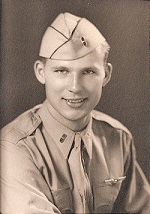
2nd Lt. Gordon A. Zempel served as a B-17 pilot during WWII, and he continued to serve in the USAF Reserve until his death at age twenty-three on January 24, 1948. 2nd Lt. Zempel disappeared in a USAF North American Aviation T-6D while on a routine proficiency flight from Norton Air Force Base. The wreck of his aircraft was not discovered until August 6, 1948 in the San Bernardino Mountains. (Photo courtesy William H. Zempel)
AT-6D Video
Project Remembrance |
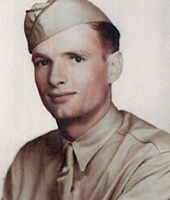
Sgt. James B. Shelton, USAAF was an assistant flight engineer on a B-24D that disappeared while on a routine training mission in October 1943. (Photo courtesy Marc McDonald via the Shelton Family)
On October 6, 1943 Consolidated B-24D 41-24041 departed Pocatello Army Air Field in Idaho for an over water navigational training mission to the Pacific Ocean southwest of Fort Dick, California. The B-24D was to have made radio contact with shore stations every thirty minutes until they landed at Hamilton Field in California. The only radio message received was at Klamath Falls, Oregon. When 41-24041 failed to arrive at Hamilton Field the aircraft and its crew of ten were posted missing, and were presumed to be lost at sea. No trace of the B-24D or its crew has ever been found. Search missions were flown over the wilds of southwestern Oregon, and northwestern California in case the ill-fated B-24D had crashed on land.
|
|
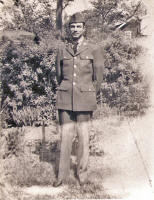
USAAF Assistant Radio Operator Private Vern Bassett Smith
lost his life aboard B-24D 41-24262 on December 6, 1942 along with five
other air crewmen. The accident was caused by an engine malfunction
coupled with heavy clouds and icing conditions near the crash site nine
miles southeast of Stewarts Point, CA. (Photo courtesy Jacquelyn
Morrison)
B-24D Story
Project
Remembrance |

USAAF Flight Officer Frank J. Pryor and his wife in photo
taken one month before his death in the Crash of B-24J on Mt. Harrison
in Idaho. F/O Pryor was the navigator aboard 41-100050. (Photo courtesy
Craig Fuller via Marc McDonald) |
|

Lieutenant Edward F. Bickford served with distinction during WWII in Europe assigned to the 9th Air Force. He flew sixty-eight combat missions with the 356th Fighter Squadron, shooting down 5.5 enemy aircraft. Lt. Bickford earned the Distinguished Flying Cross and the Air Medal with four Oak Leaf Clusters for heroism.The 356th Fighter Squadron received a Presidential Unit Citation during Lt. Bickfordís combat tenure.
Lt. Bickford remained in the army air force reserve following the war, and had completed his first year at Cal Tech. He was twenty-three at the time of his death in the crash of a USAAF AT-6C Texan, 42-48918 on July 2, 1947. The accident occurred following a fly-over of his home in Altadena, California. After performing a few aerobatic maneuvers he flew north into the San Gabriel Mountains, and up a steep canyon where he crashed. He was survived by his wife, and a year old daughter. (Photo courtesy Eileen Vesely) |

Lt. Edward F. Bickford in combat flying gear while assigned to the 356th Fighter Squadron. (Photo USAF Official via Eileen Vesely)
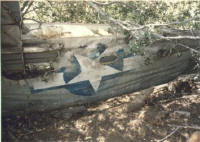
Photo depicts the right wing of the AT-6C with star and bar insignia (Photo by G.P. Macha circa 1989) |

Lt. (jg) Jack E. Joynson was twenty-four years old when
he died in the crash of a U.S. Navy Douglas AD-6 Skyraider on July
6, 1960 near Big Bear Lake, CA. Lt. (jg) Joynson was serving with VA-215
at the time of his death. (Photos courtesy Jack E. Joynson, Jr.)
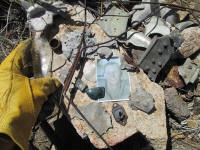
-
On June 21, 2014 members of the Project Remembrance Team
located the crash site of the U.S.N. Douglas AD-6 flown by Lt.(j.g.)
Jack E. Joynson. The pilotís son visited the crash site on August 8,
2014 accompanied by the Project Remembrance Team. (Photo by Pat J. Macha)
|
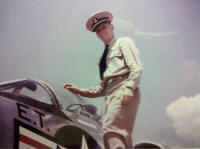
-
 Tribute for Jack E. Joynson written by his son, Jack E. Joynson Jr.
Tribute for Jack E. Joynson written by his son, Jack E. Joynson Jr.

|
|
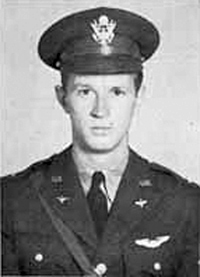
1st Lt William Henry
Birrell was a West Point graduate who received his wings on March 14,
1941. On October 24th, 1941 1st Lt. Birrell crashed to his death near Bass
Lake, while flying P-40 39-200. 1st Lt. Birrell was one of five 57th
Pursuit Group pilots to crash or bailout over the High Sierra on that
fateful day. (Photo via Tony Kirzan)
P-40 Story
Project
Remembrance
|
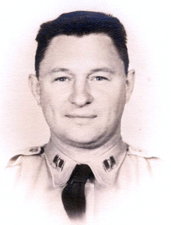
Captain John Phillips, Jr. was flying a Boeing KC-97G
assigned to the Strategic Air Commandís 96th Air Refueling Squadron when
he crashed in the cloud enshrouded Box Springs Mountains on June 27, 1954.
The accident occurred at 1:58 AM as the KC-97G approached March Air Force
Base in Riverside County, CA. Captain Phillips and all thirteen of his
passengers and crew were tragically killed in this weather related loss.
(Photo courtesy Edward Phillips)
 Video:
Video:

KC-97G Stratotanker
at Box Springs Mt, CA
Project
Remembrance
|
|

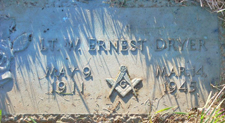
USAAF 2nd Lt. William E. Dryer looking sharp and confident
less than a year before his untimely death on cloud enshrouded Mt. Pinos
in San Diego County, CA. 2nd Lt. Dryer was flying BT-13A 41-22019 while
engaged in a cross-country navigational training flight on March 14, 1945
along with Cpl. Joseph F. Schubert, his ride along passenger. (Photo
courtesy David D. Dryer)
|
|

2nd Lt. Richard N. Long,
USAAF pilot that lost his life on 10/24/41 in Curtiss P-40 39-287. The
wreckage of 2nd Lt. Longís P-40 was not discovered until July 1959 when
hikers accidentally spotted the the plane near South Guard Lake in the
High Sierra. (Photo courtesy Joshua Long)
|
|
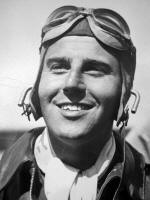
USAAF Bombardier Instructor, 1st Lt. Bernard Corman was killed along with two of his students on 8/13/43 when the USAAF Beechcraft AT-11 #42-27429 that he was flying in, crashed NW of Hinckley on the Mojave Desert. Also killed was the pilot of the AT-11. (Photo USAAF Official) |
|
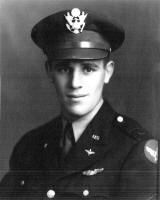
Captain
George F. Bingham was the senior pilot and aircraft commander
aboard Douglas C-47D #42-1124 when it crashed on Mt. San Gorgonio
on 12/1/52 killing all thirteen men on board.
Weather, darkness, and lack of a VOR at the Palm
Springs Intersection were cited as factors in this accident.
Captain Bingham had served with the USAAF during WW II, and he continued
to serve in the USAF until his untimely death on 12/1/52. (Photo
courtesy of the George F. Bingham Family)
C-47D Story |